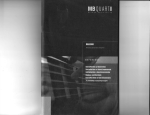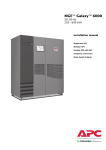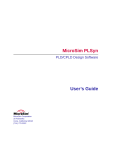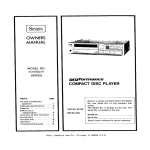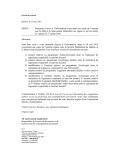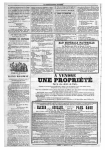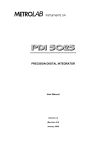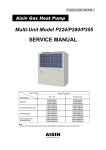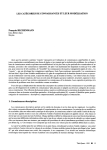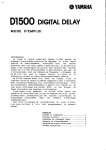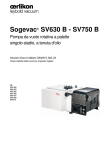Download civil engineering and installation manual
Transcript
RM6 MV distribution factory built assemblies at your service ENGLISH civil engineering and installation manual Released for Manufacturing Printed on 2012/09/13 group Schneider Electric service centers are there for: engineering and technical assistance start-up training preventive and corrective maintenance adaptation work spare parts Call your sales representative who will put you in touch with your nearest group Schneider Electric service centers. SCHNEIDER ELECTRIC 35 rue Joseph Monier CS 30323 92506 RUEIL MALMAISON CEDEX Tél : +33 (0)1 41 29 70 00 Fax :+33 (0)1 41 29 71 00 07897071EN01 revision : 08 http://www.schneider--- electric.com As standards, specifications and designs change from time to time, please ask for confirmation of the information given in this publication. Conception, rédaction: Service Documentation Technique T&D Released for Manufacturing Printed on 2012/09/13 Edition du : 2012 ---09 ---05 foreword . . . . . . . . . . . . . . . . . . . . . . . . . . . . . . . . . . . . . . . . . . . . . . . . . . . . . . . . . . . . . . . . . . . . . . . 3 symbols and conventions . . . . . . . . . . . . . . . . . . . . . . . . . . . . . . . . . . . . as per iso 3864---2 . . . . . . . . . . . . . . . . . . . . . . . . . . . . . . . . . . . . . . . . . . distribution rules . . . . . . . . . . . . . . . . . . . . . . . . . . . . . . . . . . . . . . . . . . . . safety rules . . . . . . . . . . . . . . . . . . . . . . . . . . . . . . . . . . . . . . . . . . . . . . . . 3 3 4 4 description of range sizes and weights . . . . . . . . . . . . . . . . . . . . . . . . . . . . . . . . . . . . . . . . . . 5 1 function range . . . . . . . . . . . . . . . . . . . . . . . . . . . . . . . . . . . . . . . . . . . . 2 functions range basic . . . . . . . . . . . . . . . . . . . . . . . . . . . . . . . . . . . . . . 2 functions range / free combination . . . . . . . . . . . . . . . . . . . . . . . . . . 3 functions range basic . . . . . . . . . . . . . . . . . . . . . . . . . . . . . . . . . . . . . . 3 functions range / free combination . . . . . . . . . . . . . . . . . . . . . . . . . . free combination . . . . . . . . . . . . . . . . . . . . . . . . . . . . . . . . . . . . . . . . . . . . 4 functions range basic . . . . . . . . . . . . . . . . . . . . . . . . . . . . . . . . . . . . . 5 functions . . . . . . . . . . . . . . . . . . . . . . . . . . . . . . . . . . . . . . . . . . . . . . . . . metering cubicle . . . . . . . . . . . . . . . . . . . . . . . . . . . . . . . . . . . . . . . . . . . . handling . . . . . . . . . . . . . . . . . . . . . . . . . . . . . . . . . . . . . . . . . . . . . . . . . . . by forklift truck . . . . . . . . . . . . . . . . . . . . . . . . . . . . . . . . . . . . . . . . . . . . . before installation and energising . . . . . . . . . . . . . . . . . . . . . . . . . . . . . unit with manometer . . . . . . . . . . . . . . . . . . . . . . . . . . . . . . . . . . . . . . . . unit with pressure switch . . . . . . . . . . . . . . . . . . . . . . . . . . . . . . . . . . . . storage . . . . . . . . . . . . . . . . . . . . . . . . . . . . . . . . . . . . . . . . . . . . . . . . . . . . unpacking on site . . . . . . . . . . . . . . . . . . . . . . . . . . . . . . . . . . . . . . . . . . . checking the accessories delivered with the unit . . . . . . . . . . . . . . . . technical data . . . . . . . . . . . . . . . . . . . . . . . . . . . . . . . . . . . . . . . . . . . . . . characteristic for free combination and 5 functions . . . . . . . . . . . . . . identification . . . . . . . . . . . . . . . . . . . . . . . . . . . . . . . . . . . . . . . . . . . . . . . 5 5 6 6 7 7 8 8 9 10 10 12 12 13 16 17 18 19 19 20 installation recommendation . . . . . . . . . . . . . . . . . . . . . . . . . . . . . . . . . . . . . . . . . . . . . . . . . . . . 21 reminder . . . . . . . . . . . . . . . . . . . . . . . . . . . . . . . . . . . . . . . . . . . . . . . . . . . recommendation . . . . . . . . . . . . . . . . . . . . . . . . . . . . . . . . . . . . . . . . . . . 21 21 sizing of the civil engineering . . . . . . . . . . . . . . . . . . . . . . . . . . . . . . . . . . . . . . . . . . . . . . . . . . . 23 for network switch or network circuit breaker . . . . . . . . . . . . . . . . . . . for fuse---switches . . . . . . . . . . . . . . . . . . . . . . . . . . . . . . . . . . . . . . . . . . additional raising block . . . . . . . . . . . . . . . . . . . . . . . . . . . . . . . . . . . . . . for DE---Mt metering cubicle . . . . . . . . . . . . . . . . . . . . . . . . . . . . . . . . . . duct detail for switchboard with MV metering . . . . . . . . . . . . . . . . . . . 23 24 25 26 27 fitting and fixing on the civil engineering . . . . . . . . . . . . . . . . . . . . . . . . . . . . . . . . . . . . . . . . . 29 fixing to the ground . . . . . . . . . . . . . . . . . . . . . . . . . . . . . . . . . . . . . . . . . installing the substation for resistance to internal arcing . . . . . . . . . 31 32 connection instructions . . . . . . . . . . . . . . . . . . . . . . . . . . . . . . . . . . . . . . . . . . . . . . . . . . . . . . . . . 35 connecting the HV cables . . . . . . . . . . . . . . . . . . . . . . . . . . . . . . . . . . . . type of usable connections . . . . . . . . . . . . . . . . . . . . . . . . . . . . . . . . . . connecting the HV cables . . . . . . . . . . . . . . . . . . . . . . . . . . . . . . . . . . . . instructions . . . . . . . . . . . . . . . . . . . . . . . . . . . . . . . . . . . . . . . . . . . . . . . . methods and fabrication of cable connections . . . . . . . . . . . . . . . . . . connection for NE function cubicle 1 . . . . . . . . . . . . . . . . . . . . . . . . . . methods and fabrication of cable connections . . . . . . . . . . . . . . . . . . LV connection . . . . . . . . . . . . . . . . . . . . . . . . . . . . . . . . . . . . . . . . . . . . . . LV compartment customer power supply . . . . . . . . . . . . . . . . . . . . . . customer connection example . . . . . . . . . . . . . . . . . . . . . . . . . . . . . . . . switch, circuit ---breaker, earthing switch indication . . . . . . . . . . . . . . fuse blowing indication . . . . . . . . . . . . . . . . . . . . . . . . . . . . . . . . . . . . . . fault tripping indication . . . . . . . . . . . . . . . . . . . . . . . . . . . . . . . . . . . . . . tripping coil . . . . . . . . . . . . . . . . . . . . . . . . . . . . . . . . . . . . . . . . . . . . . . . . pressure switch connection . . . . . . . . . . . . . . . . . . . . . . . . . . . . . . . . . . connecting a Sepam 10 relay . . . . . . . . . . . . . . . . . . . . . . . . . . . . . . . . installing an ATS (Automatic Transfer System) . . . . . . . . . . . . . . . . . . installing an ATS/ACO . . . . . . . . . . . . . . . . . . . . . . . . . . . . . . . . . . . . . . . detection sequence (ATS/VD23) . . . . . . . . . . . . . . . . . . . . . . . . . . . . . . parameter display (ATS/VD23) . . . . . . . . . . . . . . . . . . . . . . . . . . . . . . . Released for Manufacturing 35 36 37 38 39 41 43 46 47 48 49 49 49 50 51 52 66 67 70 71 07897071EN01 revision : 08 Printed on 2012/09/13 1 Configuration of thresholds and time delays(ATS/VD23) . . . . . . . . . remote control . . . . . . . . . . . . . . . . . . . . . . . . . . . . . . . . . . . . . . . . . . . . . . 2 71 73 Released for Manufacturing Printed on 2012/09/13 07897071EN01 revision : 08 foreword symbols and conventions Caution: you will find all the symbols below throughout the document, indicating the hazard levels depending on the different types of situation. DANGER DANGER: failure to follow this instruction will result in death or serious injury. AVERTISSEMENT WARNING: failure to follow this instruction may result in death or serious injury. as per iso 3864 -- 2 ATTENTION CAUTION: failure to follow this instruction may result in injuries. This alert signal can also be used to indicate practices that could damage the SM6 unit. INFORMATION--ADVICE We draw your attention to this specific point. Released for Manufacturing 07897071EN01 revision : 08 Printed on 2012/09/13 3 contact the Schneider Electric service unit for diagnosis and advice call your sales representative who will put you in contact with the closest SCHNEIDER ELECTRIC service center A RESPONSIBLE BEHAVIOR IS THE GUARANTEE OF YOUR SAFETY AND THAT OF OTHERS distribution rules CAUTION CAUTION The aim of this publication is to enable the SM6 unit to be installed correctly. safety rules CAUTION All the operations described below must be performed in compliance with applicable safety standards, under the responsibility of a competent authority. WARNING This document is not a commercial document.It is a strictly technical document drawn up by Schneider Electric. CAUTION The contractor must be certified and authorised to manipulate and perform work on the SM6 unit. Only undertake the work after having read and understood all the explanations given in this document. If you have any difficulty complying with these rules, please contact Schneider Electric. protective equipment For each operation, it is mandatory to use safety equipment appropriate: --- Personal Protective Equipment (PPE) --- Collective Protection Equipment (CPE) 4 Released for Manufacturing Printed on 2012/09/13 07897071EN01 revision : 08 description of range sizes and weights 1 function range function weight (kg) length (mm) I NE D 135 L= 472 B I L’=472+30+30=532 D DE B 135 Q 185 1142 L’=572+30+30=632 30 30 L’=472+30+30=532 cable connection RE LE O L’=472+30=502 135 L L’ 710 L’=472+30+30=532 DE bus coupler Ic DE Bc L’=572+30+30=632 145 NE = No Extensible DE = Double Extensible LE = Left Extensible RE = Right Extensible 30 30 30 30 NE RE LE DE L L L’ L L’ L L’ 2 functions range basic function QI NE DI, BI II RE II weight (kg) 180 155 length (mm) 1142 L= 829 L’= 829+30= 859 L L’ Released for Manufacturing 07897071EN01 revision : 08 Printed on 2012/09/13 5 2 functions range / free combination function length (mm) NE L= 1052 LE L’=1052+30=1082 RE DE L’=1052+30+30=1112 L L’ All function can be FREE combination Below possible example : function weight (kg) II IO OI OO 205 ID DI IB BI 215 IQ QI OQ QO 240 DD BB DQ QD 225 BQ QB QQ 250 275 3 functions range basic NE function weight (kg) IQI 275 III IDI 240 IBI 250 RE-- IQI 275 RE-- III RE RE-- IDI 240 RE-- IBI 250 IQI 275 III DE 6 length (mm) IDI IBI 240 L= 1186 L’ = 1186+30=1216 L L’ = 1186+30+30=1246 L’ 250 Released for Manufacturing Printed on 2012/09/13 07897071EN01 revision : 08 3 functions range / free combination function length (mm) NE L= 1532 LE RE DE L’=1532+30=15622 L’= 1532+30+30=1592 L L’ All function can be FREE combination Below possible example : function weight (kg) function weight (kg) III OOO 305 IQD IDQ DIQ 350 IIO IOI OII 305 QDI QID DQI 350 IOO OIO OOI 305 IQQ QIQ 375 IID IDI DII 315 DDD BBB 335 IIB IBI BII 315 QQQ IIQ IQI QII 340 IDD DID DDI 325 IBB BIB BBI 325 410 free combination with bus coupler function length (mm) RE L= 1532+30=1562 DE L’=1532+30+30= 1592 L L’ Below possible example : functions weight (kg) IIIc IBIc functions weight (kg) 320 DDIc BBIc 340 330 DDBc BBBc 350 IIBc IDIc DIIc BIIc 330 QQIc 390 IQIc QIIc 355 QQBc 400 IQBc QIBc 365 Released for Manufacturing 07897071EN01 revision : 08 Printed on 2012/09/13 7 4 functions range basic NE RE DE function weight (kg) length (mm) IIQI 355 IIII 320 IIDI / IIBI 330 QIQI 390 BIBI / DIDI 340 DIDI 340 IIQI 355 IIII 320 IIDI / IIBI 330 QIQI 390 BIBI 340 DIDI 340 IIQI 355 IIII 320 IIDI / IIBI 330 L’=1619+30+30= 1679 function weight (kg) length (mm) IIIQI 485 IBIQI 495 IIIII 450 IIIDI / IIIBI 460 IQIQI 520 IBIBI /IDIDI 470 IIIQI 490 IBIQI 500 IIIII 455 IIIDI/ IIIBI 465 IQIQI 525 IBIBI/ IDIDI 475 IIIQI 495 IBIQI 505 IIIII 460 IIIDI/ IIIBI 470 IQIQI 530 IBIBI/ IDIDI 480 L= 1619 L L’ L’ = 1619+30 = 1649 NE = No Extensible DE = Double Extensible LE = Left Extensible RE = Right Extensible 5 functions NE RE/LE DE 8 L= 2000 L’=2000+30=2030 L L’ L’=2000+30+30= 2060 Released for Manufacturing Printed on 2012/09/13 07897071EN01 revision : 08 arrester option 1142 mm 175 mm 710 mm 859 mm metering cubicle with LV compartment function 420 length (mm) L= 1106 1606 DE_Mt weight (kg) 901 L without LV compartment DE_Mt weight (kg) 400 length (mm) 1174 function L= 1106 L 901 Released for Manufacturing 07897071EN01 revision : 08 Printed on 2012/09/13 9 handling A handling pallet is fixed beneath the RM6 switchgear. This device enables fork handling of the devices. silk ---screen printed instructions on the transport cover CAUTION It is important to pay particular attention to the information affixed to the transport cover before carrying out any kind of handling operations. keep away from rain handle with care this way up keep away from sunlight maxi 70˚C Storage Temprain keep away from high gravity center do not walk on it not stack dodo not stack mini --- 40˚C by forklift truck A The handling solution (A) is to be used only for narrow areas where handling solution (B) is impossible. B Make sure that in case (A) the forks are considerably longer than half the length of the pallet. comply with the positioning of the forks The truck’s forks must be engaged underneath the entire width of the RM6 unit. 10 Released for Manufacturing Printed on 2012/09/13 07897071EN01 revision : 08 “centre of gravity” transport 1 CAUTION 1 1 : high centre of gravity transport conditions Wedge the RM6 unit securely during transport. reminder CAUTION Do not place anything on the RM6 unit. Do not walk on the RM6 unit. DO NOT STACK acceptance make sure the delivered RM6 unit is complete carry out a visual inspection of the functional components verify the characteristics indicated on the nameplates, compared to the initial order Refer to the “characteristics” chapter : the plastic cover must be in position on the RM6 unit and in good condition when it arrives. Released for Manufacturing 07897071EN01 revision : 08 Printed on 2012/09/13 11 before installation and energising Check the SF6 gas pressure for units fitted with a manometer or a pressure switch. unit with manometer Case 1: needle in green zone The RM6 unit is in normal operational status (ready for energising). Case 2: needle in red zone WARNING The RM6 unit must be replaced. The RM6 unit must not be switched on. warning label recalls the safety rules Depending on ambient temperature do not operate this equipment when needle is in red zone. Failure to follow this instruction will result in irreversible equipment damage. Refer to leaflet 07897073 “Instructions foruse“ 12 Released for Manufacturing Printed on 2012/09/13 07897071EN01 revision : 08 unit with pressure switch If nothing is displayed, check that the 8---point connector on the pressure switch wiring harness at the rear of the LCD display is correctly connected. Contact the after sales service. www.schneider-- electric.com Note: The LCD display is self---powered by piezoelectric buttons (”TEST” and “DENSITY SWITCH”). Pressing on one of these buttons will light up the display for a few seconds. LCD display check WARNING Reminder: checks are carried out with THE POWER OFF. Press the “TEST” button. The LCD screen should display: pressure check The RM6 unit is in normal operational status (ready for energising) Press the “DENSITY CHECK” button. The LCD screen displays: Case 1: OK The RM6 unit must be replaced. Case 2: LOW / OK CAUTION Case 3: VERY LOW / NOT OK The RM6 unit must be replaced. The RM6 unit must not be switched on. WARNING Released for Manufacturing 07897071EN01 revision : 08 Printed on 2012/09/13 13 warning label recalls the safety rules information CAUTION In the event of an anomaly, indicate the necessary issues to the carrier. The functional unit must remain on its base in its original packing materials when it is stored, until it is taken to its installation site. 14 In a case of visible damage or anomalies, do not install the RM6 unit. Contact SCHNEIDER ELECTRIC immediately. Reminder: telephone numbers indicated in the first chapter of this document. Released for Manufacturing Printed on 2012/09/13 07897071EN01 revision : 08 handling by slings with hooks If the minimum sling lengths cannot be implemented, use a lifting beam. L 120o maxi CMU =400 KG CE Schneider Electric CAUTION B A Do not handle a substation using slings, if the LV trunking or mimic panel front plate are not fitted. The handling by lugs are reserved only for handling RM6 substations. A : HM12 screws nuts and A : nut and screws HM12 B : CMU = 400KG CE C C :if the holes are deformed (roundness) replace the lugs. B for 5 functions A : bolt and screws HM12 B : CMU = 550KG CE C :if the holes are deformed (roundness) replace the lugs. Schneider Electric A <90˚ B B lifting beam ( capacity > 550 kg) 2 handling by slings handling by lifting beam choice of slings to be used 2 functions (mm) 3 functions (mm) 4 functions (mm) length cubicle (L) 829 1186 1619 length cable minimun 700 700 1000 2 functions for free combination (mm) 3 functions for free combination (mm) 5 functions (mm) length cubicle (L) 1052 1532 2000 length cable minimun 700 1000 1500 RM6 for free combination FREE combination Released for Manufacturing 07897071EN01 revision : 08 Printed on 2012/09/13 15 storage +70˚C CAUTION ---40˚C When stored, the equipment must remain in its original packing. It must be stored under shelter, on a dry floor or on a material insulating it from the damp. Clean using a sponge and clear water. Do not use alcohol or other solvents to clean. Following prolonged storage, all the insulating parts must be thoroughly cleaned before use. The panels must be dusted using a dry, clean cloth. remember Maxi 70˚C High gravity center Do not walk on it Do not stack Mini ---40˚C storage (continued) CAUTION 16 Keep the RM6 unit under its original plastic cover throughout the whole storage period Released for Manufacturing Printed on 2012/09/13 07897071EN01 revision : 08 specific recommendations for long ---term storage regularly check the condition of the protective cover unpacking on site Remove the packing cover. Place the device on the ground. After unpacking, the remaining materials (plastic cover + wooden pallet) must be sorted and routed to the appropriate recycling systems. When unpacking, check the functioning of the RM6 units by carrying out a few actions. Remove the handling pallet. NB: the front plinth MUST remain in position. Lift up the substation in order to remove the handling pallet. handling using rollers After unpacking and dismantling of the handling kit. Slide the RM6 unit on several cylindrical rollers. Move it to its definitive installation position . Released for Manufacturing 07897071EN01 revision : 08 Printed on 2012/09/13 17 checking the accessories delivered with the unit actuating lever (long version) We draw your attention to this specific point. The actuating lever is a MANDATORY requirement in order to install the RM6 unit and put it into operation. actuating lever (basic) CAUTION Reminder: the original RM6 lever must be used; it is delivered with the RM6 unit. IF THE LEVER IS MISSING ? CALL YOUR SALES REPRESENTATIVE WHO WILL PUT YOU CONTACT WITH THE CLOSEST SCHNEIDER ELECTRIC GROUP SERVICE CENTRE YOU CAN LOG ON TO : www.schneider---electric.com 18 Released for Manufacturing Printed on 2012/09/13 07897071EN01 revision : 08 technical data Check that the information marked on the rating plate matches the equipment ordered. RAPPEL 1 function switch 2 function circuit breaker 3 function fuse-- switch combination 4 connection busbar PP YYYY Www D nnnn sequence number day of week week of manufacture year of manufacture plant code 4 1 3 2 characteristic for free combination and 5 functions 4 1 2 3 Released for Manufacturing 07897071EN01 revision : 08 Printed on 2012/09/13 19 identification A Unit serial n° engraved on top of the case. B Unit serial n° engraved on connection bushing acess panel RM6 unit prior to 2005.04.11 1 st cas A R XX XX XXX XX R XX XX XXX XX MANUFACTURING SITE ORDER NUMBER WEEK OF MANUFACTURE YEAR OF MANUFACTURE A RM6 unit between 2005.04.11 and 2nd case March 2009 subsequent to 11.04.05 YEAR OF MANUFACTURE B 2 WEEK OF MANUFACTURE ORDER NUMBER MANUFACTURE SITE subsequent to 11.04.05 and from March 2009 RM6 unit from March 2009 3 th case PP YYYY PP YYYY Www Www D D nnnn nnnn PLANT CODE YEAR OF MANUFACTURE WEEK OF MANUFACTURE DAY OF WEEK A SEQUENCE NUMBER 20 Released for Manufacturing Printed on 2012/09/13 07897071EN01 revision : 08 installation recommendation reminder It is important to control heating phenomena causing condensation problems in sub---stations. Condensation is determined directly by the temperature of the components and the humidity level of the air introduced by the ventilation. temperature +55˚C** +40˚C This humidity level can be modified considerably by the presence of water in the basement. When the RM6 is operating, the ambient temperature must be between -- 25°C and +40°C. -- 25˚C **Above 40°C, but only CAUTION temperature nominal current recommendation up to 55°C, carry out a current derating. 40˚C 400A 45˚C 400A 50˚C 400A 55˚C 355A 630A 575A 515A 460A Ageing withstand of switchgear in an MV substation depends on several factors that must be complied with before or while installing the equipped substation. Released for Manufacturing 07897071EN01 revision : 08 Printed on 2012/09/13 21 example of correct installation rules to be complied with 1 Need for proper implementation of connections: the new cold---slip---on or retractable technologies offer an ease of installation that encourages long---term withstand. 2 The effect of the relative humidity factor: implementation of a heating resistor in the LV compartment is vital in climates with a high rate of relative humidity and with large temperature differences. 3 Ventilation control: grid size must be suited to the power lost in the substation. These grids must be placed only near the transformer, to avoid air circulation on the MV switchboard. 4 The need for brickwork construction for the ducts, equipped with a device guaranteeing absence of water stagnation: either by installation of perfect tightness at cable routing level, at the entrance to the MV substation enclosure or by installation of a device allowing evacuation of water that has accidentally entered the duct. 5 Preparation of the ground guaranteeing absence of water penetration in the ducts and rapid evacuation of water that has accidentally entered the ducts: by installation of a drain under and around the substation (sufficiently thick gravel layer). (3) 3 2 HV/LV transfo 1 LV panel RM6 (3) 3 4 (6) 6 5 5 6 Stabilisation of the ground before installing the MV substation guaranteeing absence of all ground movement and thus of the MV substation at a later stage. 22 Released for Manufacturing Printed on 2012/09/13 07897071EN01 revision : 08 sizing of the civil engineering for network switch or network circuit breaker Cables can be routed from the front, rear, left or right. 40 mini 50 maxi In the case of civil engineering without trench, a raising plinth can be optionally supplied. 70 mini 80 maxi P1 P1 P1 R 40 mini 50 maxi 90 mini 120 maxi determining trench depth (P1) for more detailed information, please contact the cable supplier connection cable insulation cable cross-- se ction (mm2) radius of curvature (mm) depth (mm) plug---in sockets draw ---out sockets dry insulator single---pole heat ---shrinkable ends dry insulator single---pole paper impregnated with non---draining material three---pole ± 50 70 to 95 120 to 150 185 to 240 300 ± 50 70 to 95 120 to 150 185 to 240 300 ±95 150 185 ± 50 95 150 240 300 370 440 500 590 640 370 440 500 590 640 550 610 650 550 635 670 775 835 270 340 400 520 540 270 340 400 520 540 660 720 770 660 750 790 900 970 Released for Manufacturing 07897071EN01 revision : 08 Printed on 2012/09/13 23 for fuse---switches H1 : 700 minimum for changing fuses H1 H1 A : plug---in (elbow type socket) B : plug---in (straight socket) The sectional area of the “transformer” output cable (functions Q and D) is usually less than that of “network” output cables (functions I and B). All the cables then pass through the same space. When using HV straight power outlets or bases, the depth “ P2” indicated below may be greater than that of “network” “P1” cables. 800 A B P2 P2 in the case of a connection with heat---shrinkable sleeve C : heat ---retractable installation of the square of connection TH 1 : to fix the square of connection under the fuse well using screw HM8.20 like its disc diameter 8 (delivered srews and bolts) c 1 CAUTION The curvature of the cables may cause partial deterioration of the fuse compartments. It is mandatory to use 520mm bases. 24 Released for Manufacturing Printed on 2012/09/13 07897071EN01 revision : 08 determining trench depth (P2) cable insulation dry insulator cable cross-section (mm2) radius of curvature (mm) plug -- in elbow type plug -- in straight heat-shrinkable single---pole 35 335 100 520 335 50 to 70 400 100 520 400 95 440 100 550 440 35 435 100 520 725 50 to 70 500 100 520 800 95 545 100 550 860 three---pole additional raising block 703 mm 703 mm The RM6 may be optionally equipped with a 260 or 520 mm raising plinth. This addition, which simplifies civil engineering works, allows a reduction in trench depth or even complete elimination of trenches when cable radius of curvature so allows. 520 mm 260 mm For these bases’ Interior Arc resistance, please contact the SCHNEIDER ELECTRIC department. 703 mm CAUTION A B Released for Manufacturing 07897071EN01 revision : 08 Printed on 2012/09/13 25 for DE---Mt metering cubicle CAUTION the width of the metering cubicle’s duct must be taken into consideration in the event of a future extension CAUTION INTERIOR ARC RESISTANCE OF THE INSTALLATION make sure that the positioning of the evacuation flap on the duct is respected, as described on the following page 146 MAXI 130 120 MINI 136 P1 244 MAXI 214 MINI CAUTION the handling rollers must not be in line with the duct. 26 Released for Manufacturing Printed on 2012/09/13 07897071EN01 revision : 08 duct detail for switchboard with MV metering A bottom view A : membrane B : flap C : duct C 10 mini 10 mini B A Released for Manufacturing 07897071EN01 revision : 08 Printed on 2012/09/13 27 ..................................................................................................................................................................... ..................................................................................................................................................................... ..................................................................................................................................................................... ..................................................................................................................................................................... ..................................................................................................................................................................... ..................................................................................................................................................................... ..................................................................................................................................................................... ..................................................................................................................................................................... ..................................................................................................................................................................... ..................................................................................................................................................................... ..................................................................................................................................................................... ..................................................................................................................................................................... ..................................................................................................................................................................... ..................................................................................................................................................................... ..................................................................................................................................................................... ..................................................................................................................................................................... ..................................................................................................................................................................... ..................................................................................................................................................................... ..................................................................................................................................................................... ..................................................................................................................................................................... ..................................................................................................................................................................... ..................................................................................................................................................................... ..................................................................................................................................................................... ..................................................................................................................................................................... ..................................................................................................................................................................... ..................................................................................................................................................................... ..................................................................................................................................................................... ..................................................................................................................................................................... ..................................................................................................................................................................... ..................................................................................................................................................................... ..................................................................................................................................................................... ..................................................................................................................................................................... ..................................................................................................................................................................... ..................................................................................................................................................................... ..................................................................................................................................................................... ..................................................................................................................................................................... ..................................................................................................................................................................... ..................................................................................................................................................................... ..................................................................................................................................................................... 28 Released for Manufacturing Printed on 2012/09/13 07897071EN01 revision : 08 fitting and fixing on the civil engineering dimensions of RM6 REs with an extension module RM6 RE 4 functional units with circuit ---breaker A=2264 mm (A=1619+43+572+30) (*) B = 900 for DE function B=1600 for 3 DE functions standard or free combinaison ( 2 functions) B=2000 for 4 DE functions standard or free combinaison ( 3 functions) D/B These dimensions can be reduced under special conditions, consult us. WARNING 150 mm mini IF THE CUBICLE ON THE RIGHT IS : DE ---Q DE ---D/B DE ---DB -- required distance from right side wall must be > 150mm to operate the RM6 cubicle preparing the ground fixing Drill the holes in the ground to the diameter necessary to fit the M6 screws. Fit the suitable dowels. Released for Manufacturing 07897071EN01 revision : 08 Printed on 2012/09/13 29 sizing for RM6 function type A (mm) B (mm) C (mm) RM6 (1 function) basic 542 416 63 RM6 (1 function) basic 642 516 63 RM6 (2 functions) basic 899 773 63 RM6 (2 functions) free combinaison 1122 996 63 RM6 (3 functions) basic 1256 1130 63 RM6 (3 functions) free combinaison 1602 1476 63 RM6 (4 functions) basic 1689 1563 63 RM6 (5 functions) 2073 1959 57 A 35 mm RM6 C B 25 mm FRONT VIEW for RM6 extensible to the right (RE) or left (LE) or (DE) A NE = Non Extensible DE = Double Extensible LE = Left Extensible RE = Right Extensible 43 43 A RM6 RM6 FRONT VIEW 30 DE or LE B 645 mm DE or RE RM6 RE = (Right) Extensible à Droite B FRONT VIEW FRONT VIEW FRONT VIEW Released for Manufacturing Printed on 2012/09/13 07897071EN01 revision : 08 fixing to the ground The RM6 must be fixed by at least 3 points. verification before installation CAUTION Position the RM6 on the civil engineering. Secure the unit using HM6 screws. the finishing on the civil engineering slab must be of high quality There must be no evenness defect greater than 7mm over a length of 2m and a width of 1m description 1 -- chamfered extremity of the stud making it possible to hammer it in without damaging the threads 2 -- class 8 nut for bichromate steel or A4 stainless steel studs depending on the version metal peg A 3 -- washer 6 5 4 32 1 4 -- smoothe stud shaft without marking 5 -- rolled expansion ring made up of two segments linked together on one side. Each segment has a boss 6 -- tapered part of the stud performing expansion A A 7 A Released for Manufacturing 07897071EN01 revision : 08 Printed on 2012/09/13 31 installing the substation for resistance to internal arcing When an installation is requested with protection against internal arcing faults, consult the diagrams below. The parts to guide the gases towards the evacuation openings (stacks) and the cooling walls are not part of the switchgear supply. These components should be adapted to each type of use. The gas evacuation kits listed below are available in the RM6 accessories. exhaust gas to the rear adaptation kit Classification according to IEC62271 -- 200: IAC AFL Internal arc resistance Maxi 24kV---16kA.1s. 1 WARNING 2000 MM evacuation of the SF6 gas after ignition of the internal arc internal arc ignition zone in the case (1) 70 mm mini internal arc ignition zone in the cable box (2) 2 2000 MM 32 Released for Manufacturing Printed on 2012/09/13 07897071EN01 revision : 08 exhaust gas to the bottom adaptation kit Classification according to IEC62271 -- 200 : IAC AFL 70 mm mini 1 Interior arc resistance Maxi 24kV---20kA.1s. WARNING 2000 MM evacuation of the SF6 gas after ignition of the internal arc interior arc zone in the case (1) internal arc zone in the cable box (2) 70 mm mini 1 2000 MM If possible the downstream compartment should open into a room that is not used. Otherwise, keep to a minimum volume of 1.5m3. Released for Manufacturing 07897071EN01 revision : 08 Printed on 2012/09/13 33 exhault gas to the bottom adaptation kit for DE_mt cubicle Classification according to IEC62271 -- 200: IAC AFL Internal arc resistance 70 mm mini Maxi 24kV---16kA.1s. WARNING 2000 MM evacuation of the SF6 gas after ignition of the internal arc internal arc zone in the case (1) 34 Released for Manufacturing Printed on 2012/09/13 07897071EN01 revision : 08 connection instructions connecting the HV cables WARNING foreword Before connecting the cables, ensure that the functional unit is in the earthing switch closed position. The cables MUST be connected with the RM6 substation fixed to the ground. The operations described below apply to all connection types. The connections will be made and used according to the manufacturer’s manual. connecting the RM6 frame to the substation earth Before connecting the HV cables, you must connect the RM6 frame to the main earth bar. access to the HV connection bushings removing the panels Remove the fuse compartment cover (lift and pull it towards you), then remove the 3 front panels (2 screws per panel). Remove the 2 top plates on the cable connection compartments (6 screws per plate). If the cable compartment is equipped with bottom plates, dismantle the front bottom plate and the tightness horns. (Optional supplies) Released for Manufacturing 07897071EN01 revision : 08 Printed on 2012/09/13 35 case of a compartment with resistance to internal arcing Remove the fuse compartment cover (lift and pull it towards you), then remove the 3 front panels. Remove the 2 top plates from the cable connection compartments (6 screws per plate), then withdraw the internal arcing protection (1 plate+1 insulator), 4 F/90M5 screws. type of usable connections WARNING The RM6 connection interfaces are defined by draft project PREN50181. The type of connections to be used depend on the interface equipping your RM6. It is defined when you place your order and depends on very precise criteria such as: The current of the connected equipment : 200A, 400A, 630A Short-- time withstand current: 12,5 KA ;16KA ;25KA Socket type: Draw ---out: sliding contact. Disconnectable: screw ---on lug. Use the connectors indicated in the catalogue. We do not guarantee the dielectric withstand over time if other types of connectors are used. If 2 cables are connected to the same bushing , use connectors designed for this purpose. draw---out sockets with controlled field 36 Mount on the interface: To install the socket at the end of the cable, comply with the ---200A ; 12,5KA 1s ; 31,5 KA peak accessory manufacturer’s manual. (A type ). ---400A ; 16KA 1s ; 40KA peak (A type ). Interface fitted with a sliding contact. Released for Manufacturing Printed on 2012/09/13 07897071EN01 revision : 08 disconnectable sockets with controlled field or non ---controlled field Mount on the interface: 630A ; 25KA 1s ; 62,5 KA peak (C type) Interface containing a M16 tapping. cable ends with heat ---shrinkable elements To install the socket at the end of the cable, comply with the accessory manufacturer’s manual Tightening torque on the interface is 50 Nm. Mount on the interface : 630A ; 25KA 1s ; 62,5 KA peak (C type) Interface containing a M16 tapping. For implementation of heat ---shrinkable elements, comply with the accessory manufacturer’s manual. Tightening torque on the interface is 50 Nm. connecting the HV cables preparing the cable ends The curvature and length of the cables must be adjusted so that no stress is exerted on the connection interfaces. 07897071EN01 revision : 08 Fit the tightness horns on the cables, if the cable compartment is equipped with bottom plates. Prepare the cable ends according to the instructions of the accessory manufacturer Released for Manufacturing Printed on 2012/09/13 37 instructions The MV cable characteristics must be taken into account when the connectors are installed on the product’s bushings. Since no mechanical load is exerted on the bushing it is possible to guarantee complete absence of damage to the product during installation. types of MV cables (single pole or three pole) The depth of the cable duct must be compatible with the cable’s curvature radius. Refer to the following chapter: civil engineering dimensioning. The unit must fixed to the ground before the MV cables are connected. CAUTION recommendation for connecting cables details In the absence of any mechanical load, the terminal line must be perfectly aligned with the line of the bushing. Only the tool recommended by the socket manufacturer must be used to facilitate installation of the socket on the bushings. 1 INCORRECT ASSEMBLY 1 2 CORRECT ASSEMBLY The cut length of the MV cable must be adjusted for each phase (three pole cables in particular). Never use a bar to pull the cable and bring the connection eyelet onto the bushing. This could damage the bushing and irrevocably damage the unit. CAUTION remember 38 INCORRECT ASSEMBLY Incorrect assembly: Make sure the cable does not pull on the bushing (1) otherwise there is a risk of damage being caused to the RM6 unit. Correct assembly: It is mandatory to correctly align the plug---in socket (2) on the bushing (1). comply with the tightening torque values indicated in the “connection instructions” chapter. when installation of the MV cables is completed, check no load is exerted by installation of the cable tightening clamps. The force exerted by the cable (standard IEC 137 and NFC on the bushing should not 66 -- 550) exceed 30 daN. Released for Manufacturing Printed on 2012/09/13 07897071EN01 revision : 08 DANGER the following operation should be performed with the unit POWERED DOWN methods and fabrication of cable connections for single pole cables 1 2 mounting screws 2 1 : remove the front bottom panel (a). X3 2 2 : cut the incoming cable to the right length. Adjust the cable length with the bushing of the RM6 unit. (b) (c) X3 3 3 (a) 1 preparation of the horn grommet 3 : slide the horn (b) inside the cable until it is embedded in the rear bottom panel (c). fabrication of cable heads Refer to the socket manufacturer . (e) (d) 4 X3 keep to the alignment between the socket (d) and the bushing (e) Released for Manufacturing 07897071EN01 revision : 08 Printed on 2012/09/13 39 plugging the socket on the bushing 5 Before plugging the socket in remember to clean the bushing and the inside of the socket with a clean cloth and then lubricate (see details below). X3 6 5 5 bis X3 6 LUBRICATE lubricate the inside of the socket X3 lubricate the bushing complement to order the lubricant contact the connector supplier cable clamping X3 7 18Nm 40 18Nm Released for Manufacturing Printed on 2012/09/13 07897071EN01 revision : 08 lift up the front bottom panel 8 2 mounting screws perform the removal actions 8 connection for NE function cubicle 1 >150 mm (NE B/D) A : incoming power B : outgoing power B 703 mm 437 mm A B B A NE ---I Released for Manufacturing 07897071EN01 revision : 08 Printed on 2012/09/13 41 connection of cable earth straps A : transformer protection function B : loop switch function A B B B Connect the earth straps of the 3 cables to the fuse compartment foil acting as the earth collector (M10 nuts). Tightening torque: 28 Nm. Connect the earth straps from the switch’s 3 cables (B) to the flange support acting as the earth collector (M10 screws). Tightening torque: 28 Nm. RM6 encorporating a general cable earth collector (option). Connect the straps to the collector located at the bottom of the cable compartment. installing the sockets on the RM6 interfaces Follow the instructions of the accessory’s manufacturer. Make sure you comply with the phases: L1 -- L2 -- L3. In the case of detachable sockets installation of the pin under the fuse compartment. Before using the silicon lubricant supplied with the connection accessories, clean the interfaces with a dry cloth. cable clamping assembly of bottom panels Single pole cable. 42 It is essential to clamp the cables. Whatever type of cable is used: Tightening torque: 18 Nm. Embed the sealing horns in the rear bottom panel. Assemble the front bottom panel (a) (4 HM6 screws). Released for Manufacturing Printed on 2012/09/13 07897071EN01 revision : 08 DANGER the following operation should be performed with the unit POWERED DOWN methods and fabrication of cable connections for three pole cables The RM6 unit arrives on the operator’s site equipped with these fittings in order to connect the cables. WARNING It is recommended to carefully follow the instructions below. preparation of the cable compartment 1 dismantling procedure 2 1 (a) unscrew the flange support (a), panel (b) (b) (c) 2 (a) (b) (c) (d) (d) Remember to recover the grommet. unscrew the 2 front bottom panel screws (d); they are held in place by the chassis stiffeners (c) Released for Manufacturing 07897071EN01 revision : 08 Printed on 2012/09/13 43 REMINDER for the rest of the intervention, you must be positioned as shown in the illustration below correct visual You must have in your possession the following 3 items: (a): “horn” grommet (b): front bottom plate (c) : cable flange support (a) (b) (c) cable fabrication for three pole cable 3 3 3 : cut the incoming cable to the right length. Adjust the cable length with the bushing of the RM6 unit. 4 (a) 4 (d) preparation of the “horn” grommet 4 : slide the horn (a) inside the cable until it is embedded in the rear bottom panel (d). 44 Released for Manufacturing Printed on 2012/09/13 07897071EN01 revision : 08 fitting the cable flange support (e) 5 satisfactory cleaning 5 : fix the cable flange support (c) under the rear bottom panel using the 2 screws (e). (c) plugging the socket on the bushing 6 X3 6 5 1/ Before plugging the socket in remember to clean the bushing and the inside of the socket with a clean cloth and then lubricate (see previous section). 6 cable clamping 7 18 Nm Released for Manufacturing 07897071EN01 revision : 08 Printed on 2012/09/13 45 reassemble the front bottom panel 8 (b) 2 mounting screws perform the removal actions in reverse order 2 2 satisfactory cleaning 2 2 (b) fitting the panels Fit the 2 top plates on the cable connection compartments, (6 screws per HM6X16 plate). If the cable compartment is fitted with an internal arcing protection, put back the protection. Ensure that you respect the layers. 1 plate + 1 insulator + top plate. access to the MV compartment Put back the front panels on the cable connection compartments (2 HM6x16 screws per panel). Put back the fuse compartment cover. LV connection Access to the LV compartment Open the LV compartment access trunking by removing the 6 HM 6X16 screws. Remove the trunking vertically. 46 Released for Manufacturing Printed on 2012/09/13 07897071EN01 revision : 08 LV compartment customer power supply DANGER the following operation should be performed with the unit POWERED DOWN without LV compartment sealable screw HM6.12 screw 1 1 : Remove the 6 HM6.12 screws, and the 2 sealable screws. 2 : LV connecting terminal 2 customer power supply access preparation customer LV power supply A : drill a hole in the LV compartment sheeting (1) to the desired diameter. AUTHORISED DRILLING ZONE 1 2 3 4 1 CAUTION 35 565 225 2 110 1 80 120 200 35 37 to avoid all risk of damage, the drilling zones must be respected 3 7 4 85 12 290 SCALE0.100 Released for Manufacturing 07897071EN01 revision : 08 Printed on 2012/09/13 47 customer connection example 2 2 : power supply cable provided by the customer non-- contractual photo The customer connection must guarantee a protection index of IP3X. CAUTION current transformer (CT) intensities and temperatures for DE_mt cubicle CHECK and RESPECT: CHECK and RESPECT: The maximum allowable intensity. This depends on the type of CT (and primary ratio used). The maximum ambient temperature. This depends on the type of CT installed. intercubicle link wiring passage B DE--Mt RM6 48 Released for Manufacturing Printed on 2012/09/13 07897071EN01 revision : 08 switch, circuit---breaker, earthing switch indication B 2O+2C B : connection terminal block. (supplied alone or with the motor mechanism option) marking the connection terminal block 1 2 3 4 5 6 7 14 15 16 8 Position of the closed HV switch: terminals 1 -- 2 and 5 -- 6. Position of the open HV switch: terminals 3 -- 4 and 7 -- 8. Position of the closed earthing switch: terminals 16 ---15 Position of the open earthing switch: terminals 14 ---16 fuse blowing indication A 24 25 26 (optional supply) A ; marking the connection terminal block fault tripping indication A circuit ---breaker function only 20 21 (optional supply) A ; marking the connection terminal block Released for Manufacturing 07897071EN01 revision : 08 Printed on 2012/09/13 49 tripping coil The operation of this accessory is guaranteed for a supply voltage of +10% and ---15% of nominal voltage. (optional supply) marking the connection terminal block + _ + 22 23 _ 22 23 CAUTION follow the polarity of the 24VDC coil gear motor on fuse ---switches or switch or circuit breaker operating mechanism connection terminal block (optional supply) The operation of this accessory is guaranteed for a supply voltage of +10% and ---15% of nominal voltage. A A connection terminal block power supply marking the connection terminal block + A 9 close 50 --- 10 11 12 13 open Released for Manufacturing Printed on 2012/09/13 07897071EN01 revision : 08 pressure switch connection The pressure switch checks the pressure of the RM6 unit and transmits the data via 2 auxiliary contacts: ”Level 1” and ”Level 2”. pressure switch functional table Pressure ”P” of the RM6 unit (absolute bar) contact status “Level 1” contact status “Level 2” Pressure check on LCD display (”DENSITY SWITCH” button(2)) P > 1,08 bar Closed Closed Case 1: OK 1,04 bar < P ± 1,08 bar Closed Open Case 2: OK/LOW P ± 1,04 bar Open Open Case 3: NOT OK/VERY LOW (2) see checks before energising page 13 This data is available by connection (B): 4 wires available under the cable trough for connection to a terminal defined by the customer for remote relay of the RM6 unit pressure status: A : heat ---shrinkable sheath B : customer power supply (please refer to the ”contacts characteristics” table) C : GMD 216 pressure switch D : pressure switch display --- wires No.3 and 4: “Level 1” auxiliary contact --- wires No.7 and 8: “Level 2” auxiliary contact B 4 7 3 8 C A CLIC ! D contact characteristics See “Start--- up instructions”. Operating voltage 24 Vdc 48 Vdc 127 Vdc 220 Vdc 100---240 Vac Released for Manufacturing 07897071EN01 revision : 08 Printed on 2012/09/13 Inductive load (A) 2,0 L/R = 20 msec 1,0 L/R = 20 msec 0,5 L/R = 20 msec 0,15 L/R = 20 msec 1 51 connecting a Sepam 10 relay The accessories fitted to the circuit breaker must be identified before connecting the relay. 1 --- Type of Sepam fitted to your RM6 (identified by the code on the front panel of the Sepam) 2 --- RM6 circuit breaker type D: 200 A B: 630 A 3 --- Whether the circuit breaker is fitted with a motor operating mechanism identification code supply voltage interpreting the identification code Sepam 10 Note the following information: Sepam model: A or B Presence of a CSH200 core balance CT Supply voltage Using this information, connect the relay in accordance with the appropriate wiring diagram (below) 52 Sepam 10 family Model B: phase and earth current maximum protection settings A: phase and earth current maximum protection settings, logic inputs and communication port Number of current inputs 4: 3 phase current inputs + 1 earth current input Sensitivity of earth current maximum protection 1: standard (0.1...24 In) CT 3: very sensitive (0.2...24 A and 2...240 A) CSH200 Supply voltage A: 24...125 V DC and 100...120 V AC E: 110...250 V DC and 100...240 V AC Connection of the inputs/outputs and the power supply to the circuit breaker are made on terminal block A. The Sepam and circuit breaker accessories have a common supply. Released for Manufacturing Printed on 2012/09/13 07897071EN01 revision : 08 motor operated circuit breaker type B or D with Sepam 10A + MX Standard sensibility CAUTION Respect voltage and polarity. Released for Manufacturing 07897071EN01 revision : 08 Printed on 2012/09/13 53 Sensitive earth default 54 Released for Manufacturing Printed on 2012/09/13 07897071EN01 revision : 08 Connecting customer terminal bloc Released for Manufacturing 07897071EN01 revision : 08 Printed on 2012/09/13 55 motor operated circuit breaker type B or D with Sepam 10B + MX Standard sensibility 56 ATTENTION CAUTION Respect voltage and polarity. Released for Manufacturing Printed on 2012/09/13 07897071EN01 revision : 08 Sensitive earth default Released for Manufacturing 07897071EN01 revision : 08 Printed on 2012/09/13 57 Connecting customer terminal bloc 58 Released for Manufacturing Printed on 2012/09/13 07897071EN01 revision : 08 circuit breaker type B or D with Sepam 10B + MX CAUTION Standard sensibility Respect voltage and polarity. Released for Manufacturing 07897071EN01 revision : 08 Printed on 2012/09/13 59 Sensitive earth default 60 Released for Manufacturing Printed on 2012/09/13 07897071EN01 revision : 08 Connecting customer terminal bloc Released for Manufacturing 07897071EN01 revision : 08 Printed on 2012/09/13 61 circuit breaker type B or D with Sepam 10A + MX CAUTION Standard sensibility Respect voltage and polarity. 62 Released for Manufacturing Printed on 2012/09/13 07897071EN01 revision : 08 Sensitive earth default Released for Manufacturing 07897071EN01 revision : 08 Printed on 2012/09/13 63 Connecting customer terminal bloc 64 Released for Manufacturing Printed on 2012/09/13 07897071EN01 revision : 08 connecting the communication port The Sepam 10A is able to communicate via a 2---wire EIA RS 485 communication port. Connection to bus connector C is made directly without accessories. A daisy chain connection is used which requires a 150 Ω end---of---line resistor Resistor ref: VW3A8306DR Terminals Connected Information Description 1 C : common. Terminal connected to 0V of the communication interface 2 S : shielding Terminal connected to the Sepam earthing terminal 3 D0 Terminal to be connected to terminal A (or L---) of the supervisor port 4 D1 Terminal to be connected to terminal B (or L+) of the supervisor port Connection is made directly to the Sepam connector C. C connecting a CSH200 core balance CT ATTENTION C The core balance CT must only measure the sum of the phase currents. The currents circulating in the screens of the 3 HV cables must be excluded. Pass the screens’ earthing braid through the CT. Check the direction the braid passes through the CT. The CSH200 is not MV insulated. It should be fitted to the part of the cable with the earthed screen. Serious injury may result if this instruction is not followed. Released for Manufacturing 07897071EN01 revision : 08 Printed on 2012/09/13 65 connection Position the CSH200 under the RM6, in the duct, or if this is not possible, in the raising block. Use the pre---mounted shielded cable that is inside the RM6 HV connection compartment. installing an ATS This unit automatically manages the power sources for the distribution network upstream of T200 to ensure the availability of... ...the power supply downstream in case of failure of one of the sources. ACO function ACO (Auto Change Over) is an automatic power source switching function with two incoming lines (SW1 and SW2). Network ATS : changeover between two MV network sources (SW1 and SW2) Generator ATS between a distribution system line and a generator (SW1 and SW2) Operating mode When the power is lost on the line in service, switch-- over to the other line is automatic. One line can be given priority over the other, with return or not to the priority line if necessary. (Automatic Transfer System) single line diagram of an AOC function RM6 pre---equipped with ATS Q I I A : power supply B,C,D : controle cables E,F :fault detection cables INTERFACE TERMINAL T200I INTERFACE BLOCK TERMINAL BLOCK A B C D EF SPLIT SENSORS SPLIT SENSORS SW1 other Functions 66 SWG ATS in ON/OFF mode : The ATS system can be switched ON or OFF from the local control panel (T200I) or remotely (SCADA system). ATS in parallel mode upon Auto return: Enables paralleling of the channels during the phase of automatic return to the priority channel. (allows return to the main line without any power interruption) G SW2 Generator ON override command: Activation of the ATS and transfer on Generator can be activated upon an order. allows periodic maintenance tests of the ATS/Generator system for example. Released for Manufacturing Printed on 2012/09/13 07897071EN01 revision : 08 BTA function BTA (Bus Tie Automatism) is an automatic power source switching function with 2 incoming lines (SW1 and SW2) and a coupler switch (SW3). Operating mode Standard mode: When the power is lost on one line, the automatic function opens the line in question and closes the coupler switch. The coupler switch is conditioned by the absence of fault current on the main power source. Locking mode after loss of power following switch-- over: After automatic switch---over in standard mode, the power supply is checked over a configurable period. If the power is lost during this period, the SW3 coupler switch is opened and the automatic function is locked. Fault detection cables Control cables Power supply SINGLE LINE DIAGRAM OF AN BTA FUNCTION 2/3 Interface terminal block Interface terminal block Split sensors CAUTION installing an ATS/ACO Split sensors The switching function will not work with faulty batteries. Remember to check the T200I batteries regularly (see T200I manual). The following equipment is required in order to install an ATS with ACO (Auto Change Over). --- RM6 pre---equipped for the ATS function --- 1 T200I support kit --- 1 T200I (TI04M-- -- -- ABBM22) --- 2 pilot wires --- 2 CTs (optional split sensors or pre---equipped) --- 2 wires for CTs Released for Manufacturing 07897071EN01 revision : 08 Printed on 2012/09/13 67 fitting the T200I support kit CAUTION The kit can be fitted to the left or right of the RM6. The T200I earthing cable (A) should be connected to the RM6 earth bar. Do not transport the RM6 + T200I once assembled. installing the T200I and connecting it to the RM6 Fit the RM6 connection cables (A) and connect them to the interface terminals (B) in the RM6 LV compartment. B B CAUTION Take care with channel markings and mismatch. The ACO unit is only available on channels 1 and 2 of the T200I. A 68 Released for Manufacturing Printed on 2012/09/13 07897071EN01 revision : 08 switch wiring diagram INTERFACE TEMINAL BLOCK 1 VD23 VPIS VO AVAILABLE 2 3 4 5 6 7 8 9 10 AVAILABLE fitting the T200I enclosure Fit the T200I and earth the enclosure (diameter 8 earth stud). Use the instructions on the CD supplied with the T200I to: --- fit and connect the core balance CTs --- fit and connect the battery --- connect the AC supply locking the source transfer This input makes it possible to forbid commands from: --- the local control panel --- the automatic switching function --- the supervisor To be wired to terminal J1 of the T200I, terminals 1---2. RM6 circuit breaker complete with a Sepam 10 relay, terminals 29---30. RM6 circuit breaker complete with a VIP relay, terminals 20---21. locking the source transfer Channels 1 to 4 fault reset output Channels 1 to 4 external indicator lamp Released for Manufacturing 07897071EN01 revision : 08 Printed on 2012/09/13 69 detection sequence (ATS/VD23) threshold paramater Configuration: voltages V1,V2,V3, direct mode R1: terminal = relay rest position: voltage loss on at least one of the phases = relay rest R2: terminal position: voltage presence on at least one of the phases A configurable time delay is applied for control of R1 and R2:T12 = time delay for R1 changeover upon voltage loss T11 = time delay for R1 changeover upon voltage recovery T21 = time delay for R2 changeover upon voltage lossT22 = time delay for R2 changeover upon voltage recovery indicator indicator suggested choice for VD23 settings VOLTAGE EARTHED OR IMPEDANT GROUNDING DETECTOR SW 1 3 4 5 6 SW 2 SW 1 ISOLATED NEUTRAL COMPENSATED NEUTRAL V1+V2+V3+V0 V1.V2.V3.V0 R1 3 4 5 6 U12+U13+U23 3 4 5 6 U12.U13.U23. SW 2 U12+U13+U23 U12.U13.U23. R1 recommendated settings thresholds T200I specific settings Phase voltage detection 50% Voltage detection--- residual earth fault voltage 54% For each channel, set the control and automation parameters Access ’ Control & Automation configuration’ RM6 control settings 70 Standard control Standard Await return of switch command position time delay 5000 ms Await return of circuit---breaker command position time delay 14000 ms Non---complementarity filtering time delay 3000 ms Operating time delay 500 ms Released for Manufacturing Printed on 2012/09/13 07897071EN01 revision : 08 Mode selection Measuring mode Test mode Product name Software version Digits test Network frequency or Type of measurement Configuration mode Parameters defined by micro switches line---to---line line---to---neutral Parameters setup mode To set the parameter values, see the section below Relay output Phase 1 inverted measured direct Voltage presence Voltage absence Calibration mode not measured Phase 2 measured not measured Phase 3 Residual voltage measured measured not measured not measured % of nominal voltage (10% increments) Phase voltage threshold to Residual voltage threshold to % of nominal voltage (10% increments) Activation time delay R1 (direct) to 0 to 1 s (0.1s increments) 1 to 21 s (2s increments) Release time delay R1 (direct) to 0 to 1 s (0.1s increments) 1 to 3 s (0.5s increments) Phase voltage threshold to % of nominal voltage (10% increments) Activation time delay R2 (direct) to 0 to 1 s (0.1s increments) 1 to 21 s (2s increments) Release time delay R2 (direct) to 0 to 1 s (0.1s increments) 1 to 3 s (0.5s increments) Automatic calibration or Forced calibration 1s Set to OFF to retain the last calibration performed Calibration performed normally Error in calibration: voltage levels too low parameter display (ATS/VD23) The and buttons allow navigation in the parameter tree structure in accordance with the following diagram. At any time, a press on the “Esc” key (Return) allows you to return to the preceding stage. Configuration of thresholds and time delays(ATS/VD23) The parameter values (white screen in the above diagram) can be modified as follows: When the value of the parameter is displayed, a press on the key causes the display to flash for 5 s During flashing, press successively to display the desired value Confirm this value by pressing the button; without confirmation within a period of 15 s, return to display of the parameters without change in the value.Each press on the “Esc” button takes you back to the preceding stage. Released for Manufacturing 07897071EN01 revision : 08 Printed on 2012/09/13 71 VD23 relay only Wiring of VD23 when there is no 48V DC motor INTERFACE TEMINAL BLOCK 1 2 3 4 5 6 7 8 VD23 R1 VPIS VO AVAILABLE MANUFACTURING WIRE AVAILABLE wiring reference according configuration or installation type R1 9 10 R2 24V ---48V + --- A 13 14 15 16 17 18 19 20 A VD23 72 Released for Manufacturing Printed on 2012/09/13 07897071EN01 revision : 08 fault current detector selectivity The Imax and Io thresholds must be configured corresponding to those configured on the protection of the upstream system circuit breaker. The thresholds and time delays to be configured on the T200I must be slightly lower than those of the upstream circuit breaker protection in order to allow the T200I to detect the presence of the fault current before the upstream circuit breaker opens. For the other parameters, use the instruction manual on the CD supplied with the T200I remote control Connecting the RM6 to the Talus 200 remote control interface. C A : TALUS 200 remote control interface B : connectors (of the Harting type) C : connecting leads A B cabling a connecting lead D 1 D : RM6 terminal block E : connection lead F : harting contact pin 2 3 4 5 6 Trunnion positions. pin side views PLUG CONNECTORS 8 9 10 11 12 13 14 15 16 17 18 5 4 2 3 E F polarisation of the HARTING connectors 7 1 2 3 4 6 7 8 9 1 2 3 4 5 10 6 7 8 9 1 6 7 1 2 3 4 6 7 8 9 1 2 2 3 4 5 6 7 8 9 10 10 5 10 5 6 7 8 9 10 10 1 2 3 4 6 7 8 9 1 2 3 4 6 7 8 9 1 2 3 4 6 7 8 9 1 2 3 4 5 10 5 10 5 10 SOCKET CONNECTORS polarisation is archived by screw ---on trunnions 10 Y Y Y Y 5 Released for Manufacturing 07897071EN01 revision : 08 Printed on 2012/09/13 73 ..................................................................................................................................................................... ..................................................................................................................................................................... ..................................................................................................................................................................... ..................................................................................................................................................................... ..................................................................................................................................................................... ..................................................................................................................................................................... ..................................................................................................................................................................... ..................................................................................................................................................................... ..................................................................................................................................................................... ..................................................................................................................................................................... ..................................................................................................................................................................... ..................................................................................................................................................................... ..................................................................................................................................................................... ..................................................................................................................................................................... ..................................................................................................................................................................... ..................................................................................................................................................................... ..................................................................................................................................................................... ..................................................................................................................................................................... ..................................................................................................................................................................... ..................................................................................................................................................................... ..................................................................................................................................................................... ..................................................................................................................................................................... ..................................................................................................................................................................... ..................................................................................................................................................................... ..................................................................................................................................................................... ..................................................................................................................................................................... ..................................................................................................................................................................... ..................................................................................................................................................................... ..................................................................................................................................................................... ..................................................................................................................................................................... ..................................................................................................................................................................... ..................................................................................................................................................................... ..................................................................................................................................................................... ..................................................................................................................................................................... ..................................................................................................................................................................... ..................................................................................................................................................................... ..................................................................................................................................................................... ..................................................................................................................................................................... ..................................................................................................................................................................... 74 Released for Manufacturing Printed on 2012/09/13 07897071EN01 revision : 08












































































